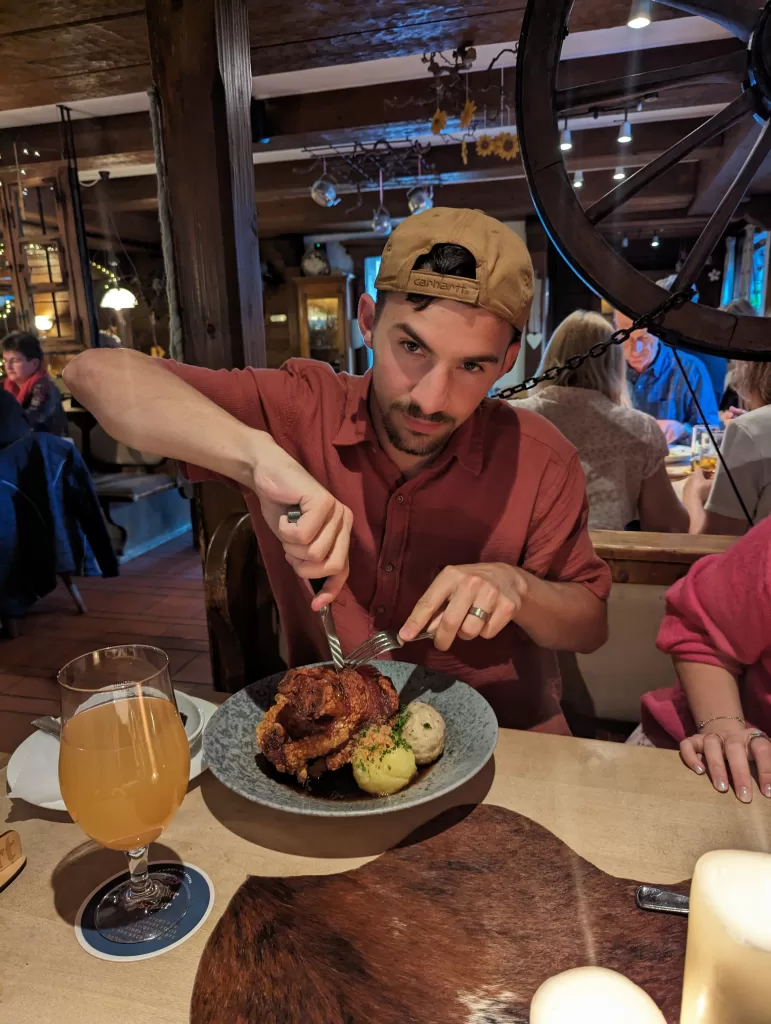The Right of Passage Bavarian Meal: Schweinshaxe
Schweinshaxe is a regional delicacy made from a whole pork knuckle that is roasted for hours until the inside is tender and the skin is crispy. When delivered to your table, it is inevitable to be stunned at the size and appearance – very much looking like something that could have graced a medieval banquet. The haxe cut of meat comes from the end of the pig’s leg, just above the ankle. There are four haxen on a pig: two forearms and two thighs with the bone intact.
Word Breakdown: Schweins = Pork, Haxe = Shank or Knuckle
Pronunciation: Sh-Vine-e-Haks-Eh

The Schweinshaxe was introduced in centuries past as a peasant dish because the haxe was an inexpensive cut of meat. Unsurprisingly for the time period and culture, no part of an animal would be left to waste. So the Germans found a way to make the haxen tasty – and they were quite successful in this endeavor. The slow cooking/roasting preparation method means that the pork is juicy and delicious by the time it reaches your plate. Schweinshaxe has become an integral part of traditional Bavarian dining experiences. It is found on menus across Bavaria and throughout the country. It is celebrated as a beloved favorite and has become a staple at festivals like Oktoberfest as well.
Austin was first introduced to the food in 2007 as a foreign exchange student in Germany. He distinctly remembers his first host father taking him to a Gasthaus and ordering the Schweinshaxe for him. It was love at first taste. Fast forward about 16 years to when we moved here as adults, Austin was immediately on a mission to find the best Schweinshaxe in our town. You see, it is imperative that the meat is served with a CRISPY outer skin. This is called the crackle and is one of the main draws to the food. The crispy crackle combined with the tender pork interior is the perfect combination, making the dish stand out as unique. Schweinshaxe is traditionally served with Sauerkraut or Blaukraut (purple cabbage) and a Knödel (potato dumpling). After sampling Schweinshaxe from a few different restaurants in town, Austin dubbed Zum Wildschütz as having the best in Garmisch. Perfectly prepared and good side dishes, not to mention a quintessential Bavarian atmosphere. The waiters always recommend the Schweinshaxe as a house specialty and it does not disappoint.

When you see these pictures, you may think, “how do you eat the Schweinshaxe?” It looks large and intimidating, but have no fear because it’s not a fine dining ritual. Just grab a knife and fork and dig in! The crispy skin might take some gentle hammering to get through, but then you’re off to the races. The tender meat interior should fall off the bone. Your best bites will contain a bit of the outer crackle along with the juicy meat. If you are so daring (and actually finish the whole thing), it is acceptable according to Germans to pick up the bone.

So how does the right of passage thing come into play? Well, that’s something we initiated just because we can. We’ve had a few visitors so far and always tell them that we’ll buy their dinner at our favorite restaurant if they can eat the whole Schweinshaxe. And that means every bite of the meat and crackle. As you can see from the photos, it’s not a small portion. Only the bravest souls take us up on the offer, but the challenge is open to anyone. We have a 50% success rate so far. The evening meat sweats are also an expected outcome after partaking in the Schweinshaxe challenge.
If you aren’t a meat lover, an alternative specialty dish to sample when visiting is the Käsespätzle. Käsespätzle is the German take on mac and cheese, usually served with roasted onions on top. It is prepared by grating small strips of dough off a wooden (sometimes wet) chopping board (spätzlebrett), directly into boiling salted water. The tiny dumplings cook in the boiling water until they rise to the surface. Of course, the cheese is an equally important ingredient to the dumplings, making this the ultimate comfort food. But instead of describing it more here, you should really just try it for yourself 😊

Regardless of which Bavarian delicacies you indulge in, you’re sure to have many unforgettable dining experiences in Germany. Remember to try something new, embrace the slow dining pace, and savor the rich flavors. As pigs are considered lucky in Germany, I’ll end this post by wishing our next fearless guest viel Glück on the right of passage Schweinshaxe challenge!

Such lovely stories, delightful memories and the phonetics are greatly appreciated!
Love that you have returned to Austin’s past, with a refreshing look forward.
I wasn’t privied to this German delicacy…hmmm, must return!
Make it a grand day!
Mama Maureen.xo